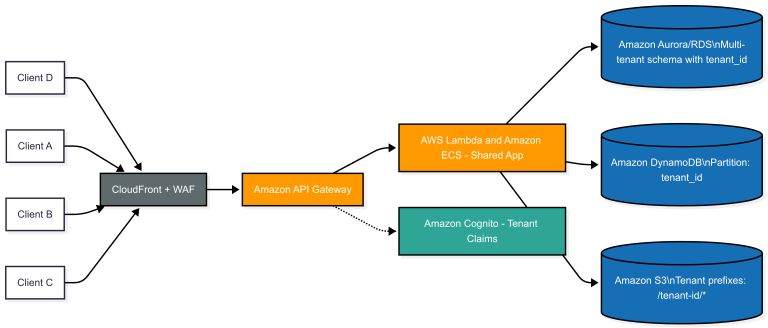[Type of SAAS Architecture]Types of SaaS Architectures for Applications on Bubble and AWS: How to Choose the Right One
When you’re building a SaaS product, your architecture is the silent boss — it decides how well your app scales, how secure it is, and how much you’ll cry (or smile) during maintenance.
Pick the wrong architecture and you’re fighting fires daily. Pick the right one, and your app feels like it was built for the future from day one.
If you’re developing on Bubble.io or leveraging AWS, your architecture options can look very different — from quick MVP builds to enterprise-grade isolation. Let’s break them down.
[Type 1]Single-Tenant Architecture
In a single-tenant SaaS setup, each customer gets their own dedicated instance of your application and database. Think of it as each tenant having their own fully furnished apartment — walls, plumbing, and locks included.
Key Characteristics
One codebase, but completely separate deployments for each customer.
Dedicated database per tenant (separate schema or separate DB instance).
Infrastructure is isolated — changes for one customer don’t affect others.
Pros
Maximum data isolation — great for regulated industries (finance, healthcare, government).
Easier to comply with GDPR, HIPAA, SOC 2, etc.
Performance is predictable — one tenant’s heavy load won’t slow others.
Customization per client is easier without breaking other customers.
Cons
Higher infrastructure cost — every new tenant requires provisioning resources.
More DevOps complexity — version control and deployment pipelines need to support multiple instances.
Scaling requires automation for provisioning and updates.
On Bubble
Single-tenant isn’t straightforward — you’d need to clone the entire app for each customer.
Useful for enterprise clients where isolation is non-negotiable.
Cloning at scale is painful unless automated with Bubble’s API + external scripts.
On AWS
Can be achieved with separate EC2/Lambda stacks, separate RDS/DynamoDB instances per client.
Tools like AWS Control Tower or CloudFormation StackSets can automate provisioning.
Ideal for government, healthcare, or high-security SaaS platforms.

[TYPE 2]Multi-Tenant Architecture
In multi-tenant setups, all customers share the same application instance and usually the same database, with data logically separated.
Imagine a high-rise building where everyone has their own apartment, but the water, electricity, and building management are shared.
Key Characteristics
One codebase, one database (often with a
tenant_idcolumn in every table).All customers share infrastructure.
Data isolation happens through software logic.
Pros
Cost-effective — infrastructure is shared.
Easier to roll out updates — change once, and it’s live for everyone.
Scales faster for startups.
Less overhead in maintenance compared to single-tenant.
Cons
Noisy neighbor problem — one heavy tenant can affect performance for all.
Data security relies on perfectly written code (risk of leakage if not careful).
Harder to meet strict compliance for regulated industries.
On Bubble
Multi-tenancy is the default way most Bubble SaaS apps are built.
Can separate data with privacy rules and constraints.
Scaling is limited by Bubble’s own infrastructure.
On AWS
Commonly implemented with single app instances + tenant-aware database queries.
Amazon Cognito for authentication + IAM for resource access control.
Can still scale massively using Aurora Serverless, DynamoDB, and Elastic Beanstalk/Lambda.

[TYPE 3]Multi-Instance Architecture
A hybrid between single-tenant and multi-tenant. Each customer has their own application instance but may share some infrastructure (e.g., a shared database cluster or backend services).
Think of it as a gated community where each house is independent but still uses the same water supply and security guard.
Key Characteristics
App codebase is the same, but instances are deployed per customer.
Some services may be shared (e.g., a central API gateway, caching layer).
Pros
Better isolation than multi-tenant, cheaper than full single-tenant.
Can support custom features per client without affecting others.
Easier to onboard large customers with specific security needs.
Cons
More infra than multi-tenant — still costlier.
Updates need coordination — not as instant as multi-tenant.
On Bubble
Possible but requires duplicating apps for each customer.
Backend APIs or shared data layers can still be centralized on AWS.
On AWS
Can use ECS/EKS/Lambda for per-tenant services while sharing backend APIs.
Good balance for SaaS targeting mid-to-large enterprises.

[TYPE 4]Hybrid: Bubble Frontend + AWS Backend
This is where things get interesting. Many startups build their UI on Bubble for speed, but push data, logic, and compliance-heavy operations to AWS.
Key Characteristics
Bubble handles client-side UI and workflows.
AWS handles APIs, AI/ML, storage, and data processing.
Can be multi-tenant, single-tenant, or multi-instance on the backend.
Pros
Fast prototyping with Bubble.
AWS scalability and compliance without rebuilding the UI.
Flexibility to offload heavy workloads from Bubble.
Cons
Two systems to maintain.
Requires integration skills (API Gateway, Lambda, Bedrock, etc.).
Example Setup
Bubble UI → AWS API Gateway → AWS Lambda → DynamoDB / RDS.
Use Amazon Bedrock for AI features.
Store documents in S3 with per-tenant access control.

Comparison Table
| Architecture | Bubble Feasibility | AWS Feasibility | Cost | Isolation | Scalability | Best For |
|---|---|---|---|---|---|---|
| Single-Tenant | Low (manual) | High | High | High | Medium | Regulated industries, high-value enterprise |
| Multi-Tenant | High | High | Low | Low-Med | High | Startups, SMB-focused SaaS |
| Multi-Instance | Medium | High | Medium | Medium | High | Mid-large enterprise SaaS |
| Hybrid | High | High | Medium | Variable | High | MVP to scale with AWS power |
Summary
- If you’re just starting, multi-tenant on Bubble will get you moving fastest.
- If you’re targeting regulated industries or enterprise clients, you’ll likely end up in single-tenant or multi-instance AWS land.
- And if you want the best of both worlds — Bubble for speed, AWS for muscle — hybrid is the sweet spot.
